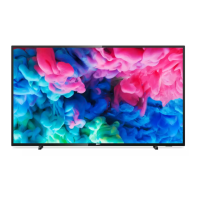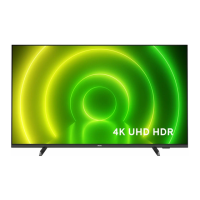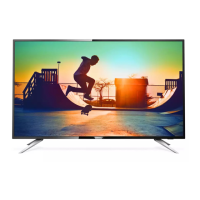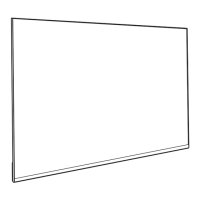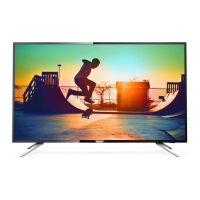Do you have a question about the Philips 50PUS8897 and is the answer not in the manual?
Explains the Home screen layout and how channels are organized.
Describes new features and navigation in updated Home launchers.
Details the Apps tab and Smart TV Collection app for accessing apps.
Provides steps to open the Home screen and select items.
Emphasizes reading safety instructions before operating the TV.
Guides on installing the TV stand or wall mounting brackets.
Offers advice on optimal TV placement for viewing and Ambilight.
Instructions for connecting and handling the TV's power cable.
Explains how to connect an antenna cable for DVB-T and DVB-C signals.
Guides on connecting a satellite F-type connector to the TV.
Details the functions of each button on the remote control.
Provides steps for pairing the remote control with the TV via Bluetooth.
Explains how to use voice commands to search for content on the TV.
Instructions for replacing batteries in the remote control.
Instructions for turning the TV on, off, and switching to standby mode.
Explains how to operate basic TV functions using the joystick key.
Guides on installing channels via antenna or cable.
Explains how channel lists are organized and displayed.
Instructions on tuning to channels, switching channels, and viewing program details.
How to create and manage lists of favorite channels for quick access.
Step-by-step guide to installing satellite channels and setting up the system.
Instructions for updating channels via antenna and manual installation.
How to copy channel lists via USB for backup or transfer to another TV.
Provides general guidance on connecting devices for optimal picture and sound quality.
Details HDMI connections, including ARC/eARC for audio and CEC for device control.
Explains how to use a CI+ CAM module for encrypted channels and smart cards.
Instructions for connecting Home Theatre Systems via HDMI and troubleshooting audio issues.
Guides on pairing, connecting, and managing Bluetooth devices like speakers or headphones.
Information on connecting and using USB devices like hard drives, keyboards, and flash drives.
How to connect a computer to the TV using an HDMI cable for use as a monitor.
Instructions for connecting the TV to a home network via Wi-Fi or wired connection.
Explains how to sign in with a Google Account to access features and apps.
Details how to use the Smart TV Collection app to download and install apps.
Introduces the Apps feature for accessing various functions and services on the TV.
Guides on using Google Play for movies, TV shows, music, and games.
Provides instructions on launching and closing applications on the TV.
Explains how to lock apps or set up restricted profiles for child safety.
Information on checking TV storage space and using USB drives for expansion.
How to access and use the TV's built-in internet browser.
Details various options available within the internet browser, like bookmarks and private tabs.
How to select and switch between connected devices and inputs.
Customizing settings for specific TV input devices.
How to rename and assign types to connected devices for easier identification.
Updates the Sources menu by rescanning for connected devices.
Information on connecting the TV to a network.
Guides on pairing, selecting, and removing Bluetooth devices.
Adjusts picture styles, colour, contrast, sharpness, and brightness for optimal viewing.
Customizes sound styles, volume, and audio output options for an enhanced audio experience.
Controls and customizes Ambilight effects, styles, and modes for immersive lighting.
Manages power-saving features like screen off and ambient light sensor for energy efficiency.
Adjusts HDMI signal quality for Ultra HD and HDR content compatibility.
Manages parental controls, app locks, and restricted profiles for content safety.
How to view media files from a computer or NAS over the home network.
How to add and view favorite media files and folders.
Viewing photos, music, and videos from connected USB storage devices.
Instructions for opening video folders, playing videos, and using playback controls.
Guides on opening photo folders, viewing photos, and using slideshow features.
How to open music folders, play music, and organize by artist or album.
Explains the purpose and requirements for using the TV Guide feature.
Information on how TV Guide data is received and its availability.
Instructions on opening, navigating, and using the TV Guide to tune to programs and set reminders.
Guides on scheduling and performing recordings of TV programs.
Instructions on how to pause and resume live TV broadcasts.
Information on using the Philips TV Remote App for smartphone control.
How to cast content from mobile devices to the TV using Google Cast.
Requirements for playing games on the TV, including app sources and gamepads.
Connecting and using wireless gamepads for playing games.
Steps to connect and play games from an external game console.
Accessing and using the gaming control bar for in-game settings and information.
Customizing Ambilight to follow video, audio, lounge light, or flags.
Instructions on how to turn off the Ambilight feature.
Accessing detailed Ambilight settings for further customization.
Using Ambilight to create ambient lighting when the TV is in standby.
Setting up a sunrise alarm using Ambilight, music, and weather forecasts.
Using Ambisleep to simulate a sunset for winding down, with automatic standby.
Connecting and configuring Philips Hue bulbs and wireless home speakers with Ambilight.
Explains the Top Picks feature for personalized recommendations.
How to use the "Now on TV" feature to find current and upcoming programs.
Accessing movies and TV shows from online rental stores.
Overview of Freeview Play features, including catch-up TV and on-demand services.
Steps to open and navigate the Freeview Play interface for watching content.
Explains Alexa voice control capabilities and requirements for setup.
Step-by-step guide to setting up and using Alexa voice commands with the TV.
Instructions for updating the TV's software via Internet or USB for new features and fixes.
How to check the current TV software version and release notes.
Enabling automatic software updates for convenience and system maintenance.
Information about the open-source software used in the television.
Information on energy efficiency, disposal, and compliance with environmental standards.
Technical details about the TV's power requirements and consumption.
Technical details on aerial and satellite reception capabilities.
Lists supported resolutions and refresh rates for computer and video inputs.
Details the available ports and connection types on the TV.
Benefits and steps for registering the TV for full support and product updates.
How to access the TV's built-in help system and search for information.
Running diagnostic tests to check TV performance and troubleshoot issues.
Solutions for common TV problems like no picture, no sound, or remote control issues.
Essential safety instructions for using the TV to prevent injury, fire, or damage.
Guidelines for cleaning and maintaining the TV screen to prevent damage.
Legal terms and conditions for using the television product.
Legal terms and privacy policies related to Smart TV features.
Terms for using apps from the Smart TV Collection.
Information regarding HDMI trademarks and licensing.
Details on HEVC patent information and advanced decoding.
Information on AMD FreeSync Premium technology for smoother gaming.
Trademarks and licensing information for Dolby Vision and Dolby Atmos technologies.
Information on DTS Play-Fi technology for wireless audio streaming.
Explains the Home screen layout and how channels are organized.
Describes new features and navigation in updated Home launchers.
Details the Apps tab and Smart TV Collection app for accessing apps.
Provides steps to open the Home screen and select items.
Emphasizes reading safety instructions before operating the TV.
Guides on installing the TV stand or wall mounting brackets.
Offers advice on optimal TV placement for viewing and Ambilight.
Instructions for connecting and handling the TV's power cable.
Explains how to connect an antenna cable for DVB-T and DVB-C signals.
Guides on connecting a satellite F-type connector to the TV.
Details the functions of each button on the remote control.
Provides steps for pairing the remote control with the TV via Bluetooth.
Explains how to use voice commands to search for content on the TV.
Instructions for replacing batteries in the remote control.
Instructions for turning the TV on, off, and switching to standby mode.
Explains how to operate basic TV functions using the joystick key.
Guides on installing channels via antenna or cable.
Explains how channel lists are organized and displayed.
Instructions on tuning to channels, switching channels, and viewing program details.
How to create and manage lists of favorite channels for quick access.
Step-by-step guide to installing satellite channels and setting up the system.
Instructions for updating channels via antenna and manual installation.
How to copy channel lists via USB for backup or transfer to another TV.
Provides general guidance on connecting devices for optimal picture and sound quality.
Details HDMI connections, including ARC/eARC for audio and CEC for device control.
Explains how to use a CI+ CAM module for encrypted channels and smart cards.
Instructions for connecting Home Theatre Systems via HDMI and troubleshooting audio issues.
Guides on pairing, connecting, and managing Bluetooth devices like speakers or headphones.
Information on connecting and using USB devices like hard drives, keyboards, and flash drives.
How to connect a computer to the TV using an HDMI cable for use as a monitor.
Instructions for connecting the TV to a home network via Wi-Fi or wired connection.
Explains how to sign in with a Google Account to access features and apps.
Details how to use the Smart TV Collection app to download and install apps.
Introduces the Apps feature for accessing various functions and services on the TV.
Guides on using Google Play for movies, TV shows, music, and games.
Provides instructions on launching and closing applications on the TV.
Explains how to lock apps or set up restricted profiles for child safety.
Information on checking TV storage space and using USB drives for expansion.
How to access and use the TV's built-in internet browser.
Details various options available within the internet browser, like bookmarks and private tabs.
How to select and switch between connected devices and inputs.
Customizing settings for specific TV input devices.
How to rename and assign types to connected devices for easier identification.
Updates the Sources menu by rescanning for connected devices.
Information on connecting the TV to a network.
Guides on pairing, selecting, and removing Bluetooth devices.
Adjusts picture styles, colour, contrast, sharpness, and brightness for optimal viewing.
Customizes sound styles, volume, and audio output options for an enhanced audio experience.
Controls and customizes Ambilight effects, styles, and modes for immersive lighting.
Manages power-saving features like screen off and ambient light sensor for energy efficiency.
Adjusts HDMI signal quality for Ultra HD and HDR content compatibility.
Manages parental controls, app locks, and restricted profiles for content safety.
How to view media files from a computer or NAS over the home network.
How to add and view favorite media files and folders.
Viewing photos, music, and videos from connected USB storage devices.
Instructions for opening video folders, playing videos, and using playback controls.
Guides on opening photo folders, viewing photos, and using slideshow features.
How to open music folders, play music, and organize by artist or album.
Explains the purpose and requirements for using the TV Guide feature.
Information on how TV Guide data is received and its availability.
Instructions on opening, navigating, and using the TV Guide to tune to programs and set reminders.
Guides on scheduling and performing recordings of TV programs.
Instructions on how to pause and resume live TV broadcasts.
Information on using the Philips TV Remote App for smartphone control.
How to cast content from mobile devices to the TV using Google Cast.
Requirements for playing games on the TV, including app sources and gamepads.
Connecting and using wireless gamepads for playing games.
Steps to connect and play games from an external game console.
Accessing and using the gaming control bar for in-game settings and information.
Customizing Ambilight to follow video, audio, lounge light, or flags.
Instructions on how to turn off the Ambilight feature.
Accessing detailed Ambilight settings for further customization.
Using Ambilight to create ambient lighting when the TV is in standby.
Setting up a sunrise alarm using Ambilight, music, and weather forecasts.
Using Ambisleep to simulate a sunset for winding down, with automatic standby.
Connecting and configuring Philips Hue bulbs and wireless home speakers with Ambilight.
Explains the Top Picks feature for personalized recommendations.
How to use the "Now on TV" feature to find current and upcoming programs.
Accessing movies and TV shows from online rental stores.
Overview of Freeview Play features, including catch-up TV and on-demand services.
Steps to open and navigate the Freeview Play interface for watching content.
Explains Alexa voice control capabilities and requirements for setup.
Step-by-step guide to setting up and using Alexa voice commands with the TV.
Instructions for updating the TV's software via Internet or USB for new features and fixes.
How to check the current TV software version and release notes.
Enabling automatic software updates for convenience and system maintenance.
Information about the open-source software used in the television.
Information on energy efficiency, disposal, and compliance with environmental standards.
Technical details about the TV's power requirements and consumption.
Technical details on aerial and satellite reception capabilities.
Lists supported resolutions and refresh rates for computer and video inputs.
Details the available ports and connection types on the TV.
Benefits and steps for registering the TV for full support and product updates.
How to access the TV's built-in help system and search for information.
Running diagnostic tests to check TV performance and troubleshoot issues.
Solutions for common TV problems like no picture, no sound, or remote control issues.
Essential safety instructions for using the TV to prevent injury, fire, or damage.
Guidelines for cleaning and maintaining the TV screen to prevent damage.
Legal terms and conditions for using the television product.
Legal terms and privacy policies related to Smart TV features.
Terms for using apps from the Smart TV Collection.
Information regarding HDMI trademarks and licensing.
Details on HEVC patent information and advanced decoding.
Information on AMD FreeSync Premium technology for smoother gaming.
Trademarks and licensing information for Dolby Vision and Dolby Atmos technologies.
Information on DTS Play-Fi technology for wireless audio streaming.
| Screen Size | 50 inches |
|---|---|
| Resolution | 3840 x 2160 (4K UHD) |
| Display Technology | LED |
| Smart TV | Yes |
| Operating System | Android TV |
| Audio Output | 20 W |
| HDMI Ports | 4 |
| USB Ports | 3 |
| Ambilight | Yes |
| Processor | Quad-core |
| Wi-Fi | Yes |
| Bluetooth | Yes |
| Ethernet | Yes |
| Built-in Speakers | Yes |
| HDR Support | HDR10+, Dolby Vision, HLG |

